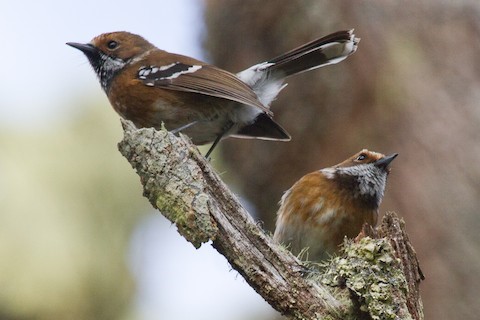Birdfinding.info ⇒ The Hawaii Elepaio has declined and retreated from some areas but remains locally common across much of the Big Island. Sites where it can usually be found include Hawaii Volcanoes National Park, the Pu’u O’o Trail along Saddle Road, Kaloko Mauka, Manuka State Park, and Pu’u La’au.
Hawaii Elepaio
Monarcha sandwichensis
Endemic to the Big Island of Hawaii, where it occurs in native forests down to around 300 m elevation.
Occurs nearly island-wide in suitable, but apparently more numerous on the eastern side, and may be locally extirpated from some lowland areas where it formerly occurred.
A somewhat isolated population of the western slopes of Mauna Kea, around 1,900 to 3,000 m elevation, averages much paler than other populations and is often recognized as a separate subspecies, C. s. bryani.
Identification
A perky little flycatcher with a long tail that it habitually cocks. Typical adult plumage is medium-brown above and rusty-brown below, with contrasting white highlights on the throat, rump, and undertail coverts, and two or three white wingbars.
The tail is dark with white tips and white outer edges when spread.
The throat is variably mixed black and white, differing by sex. Females have mostly white throats framed with black; males mostly black with white patches on the sides.
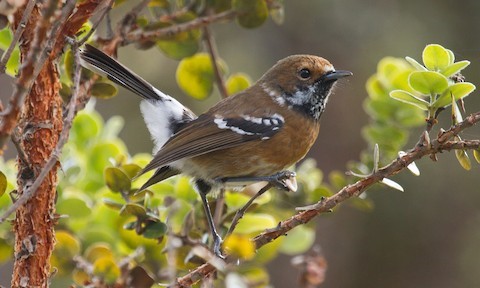
Hawaii Elepaio, male showing bright white rump and undertail coverts. (Pua Akala Tract, Hakalau Forest National Wildlife Refuge, Big Island, Hawaii; March 13, 2014.) © Eric VanderWerf
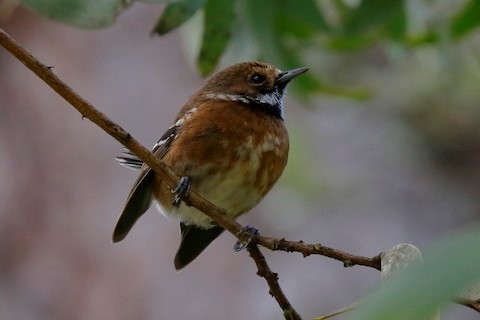
Hawaii Elepaio, male showing mostly rusty-brown underparts. (Pua Akala Tract, Hakalau Forest National Wildlife Refuge, Big Island, Hawaii; October 21, 2017.) © Sharif Uddin

Hawaii Elepaio, male. (Pua Akala Tract, Hakalau Forest National Wildlife Refuge, Big Island, Hawaii; March 13, 2014.) © Eric VanderWerf

Hawaii Elepaio, male showing bright white rump and undertail coverts. (Pua Akala Tract, Hakalau Forest National Wildlife Refuge, Big Island, Hawaii; March 13, 2014.) © Eric VanderWerf
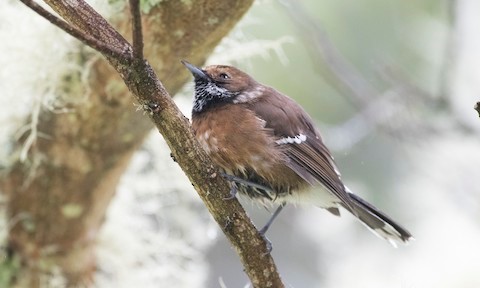
Hawaii Elepaio, male. (Pua Akala Tract, Hakalau Forest National Wildlife Refuge, Big Island, Hawaii; September 20, 2017.) © Brian Sullivan
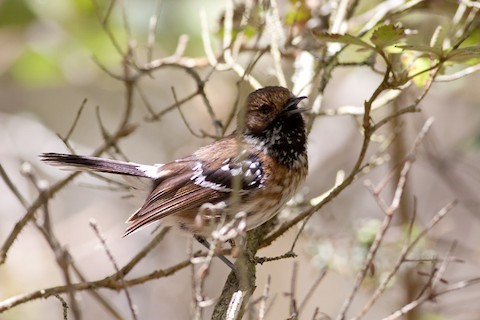
Hawaii Elepaio, male. (Pu’u O’o Trail, Kipuka Ainahou, Big Island, Hawaii; July 17, 2013.) © Michael Todd
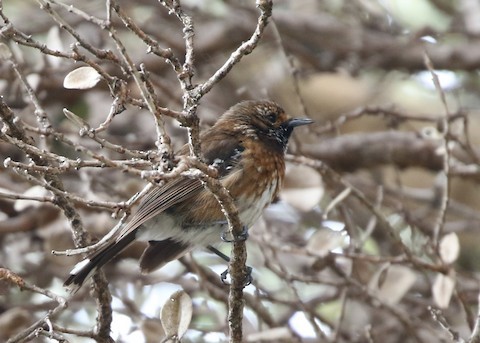
Hawaii Elepaio, male. (Pu’u O’o Trail, Kipuka Ainahou, Big Island, Hawaii; September 2, 2019.) © Dean LaTray

Hawaii Elepaio. (Pu’u O’o Trail, Kipuka Ainahou, Big Island, Hawaii; August 2, 2015.) © Steven Mlodinow
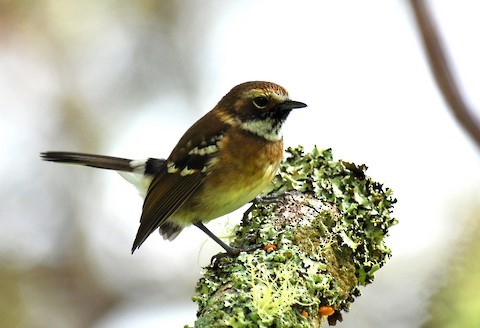
Hawaii Elepaio. (Maulua Tract, Hakalau Forest National Wildlife Refuge, Big Island, Hawaii; November 12, 2011.) © Ryan O’Donnell
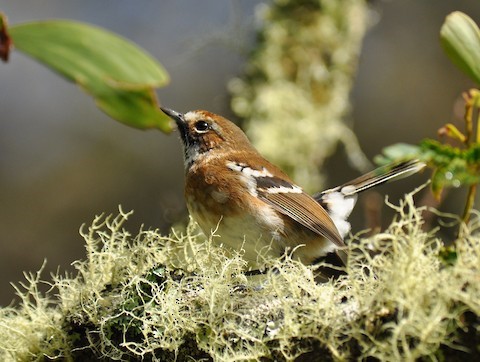
Hawaii Elepaio. (Maulua Tract, Hakalau Forest National Wildlife Refuge, Big Island, Hawaii; November 12, 2011.) © Ryan O’Donnell
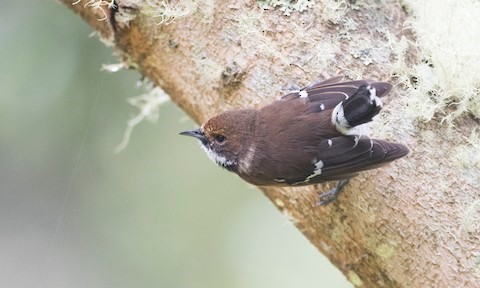
Hawaii Elepaio, showing dark-brown upperparts. (Pua Akala Tract, Hakalau Forest National Wildlife Refuge, Big Island, Hawaii; September 20, 2017.) © Brian Sullivan
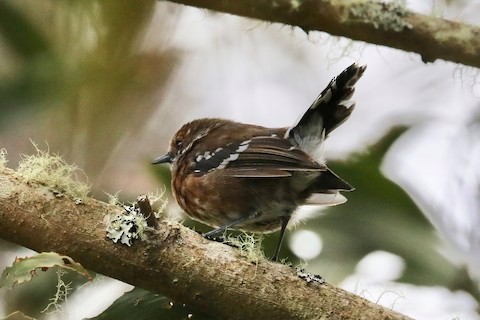
Hawaii Elepaio. (Pua Akala Tract, Hakalau Forest National Wildlife Refuge, Big Island, Hawaii; September 17, 2018.) © Steve McInnis

Hawaii Elepaio, showing mostly rusty-brown underparts. (Pua Akala Tract, Hakalau Forest National Wildlife Refuge, Big Island, Hawaii; January 4, 2020.) © Karo Fritzsche

Hawaii Elepaio, female. (Pu’u O’o Trail, Kipuka Ainahou, Big Island, Hawaii; October 21, 2017.) © Henry Burton
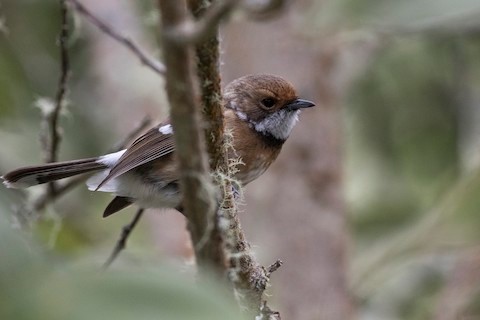
Hawaii Elepaio, female. (Hakalau Forest National Wildlife Refuge, Big Island, Hawaii; March 19, 2019.) © Jacob Drucker
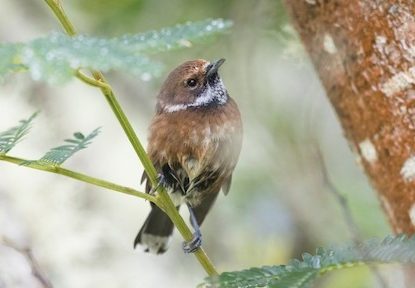
Hawaii Elepaio, female. (Pua Akala Tract, Hakalau Forest National Wildlife Refuge, Big Island, Hawaii; September 20, 2017.) © Brian Sullivan

Hawaii Elepaio, female. (Pu’u O’o Trail, Kipuka Ainahou, Big Island, Hawaii; February 26, 2019.) © Jacob Drucker
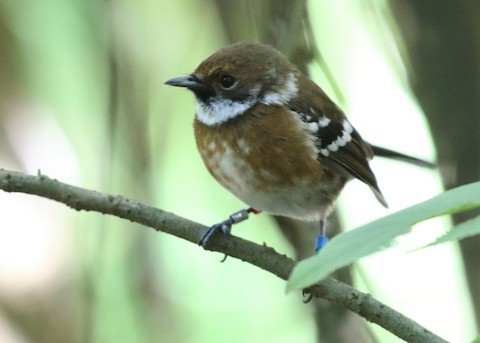
Hawaii Elepaio, female. (Kipuka Puaulu, Hawaii Volcanoes National Park, Big Island, Hawaii; September 5, 2019.) © Dean LaTray
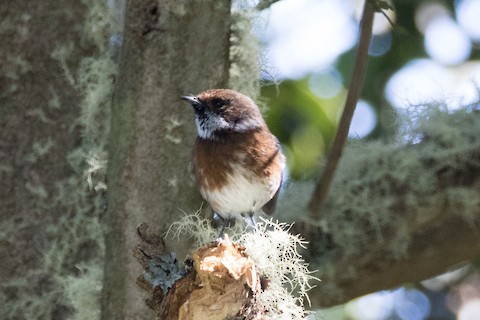
Hawaii Elepaio, female. (Hakalau Forest National Wildlife Refuge, Big Island, Hawaii; November 11, 2016.) © Bob & Bettina Arrigoni

Hawaii Elepaio. (Pu’u O’o Trail, Kipuka Ainahou, Big Island, Hawaii; September 22, 2006.) © Eric VanderWerf
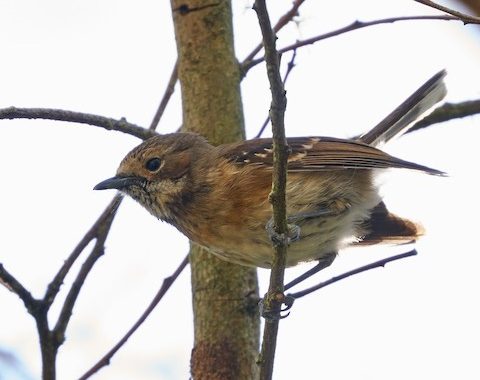
Hawaii Elepaio, female. (Mauna Loa Road, Hawaii Volcanoes National Park, Big Island, Hawaii; January 16, 2017.) © Brooke Miller
The localized north-central population, bryani, on the western slopes Mauna Kea, averages much paler overall. On some individuals the head is essentially all-white. Some members of this population resemble the typical plumage of other populations. Conversely, some members of adjacent populations have pale patches typical of bryani, and the incidence appears to be clinal.
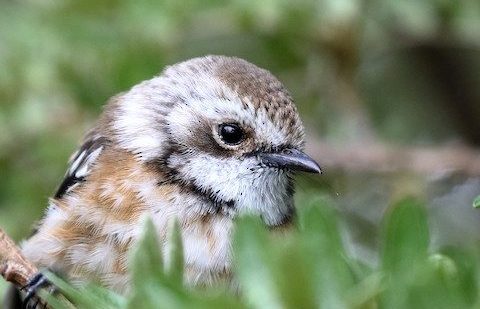
Hawaii Elepaio, C. s. bryani, showing mostly white head, as is common in this population. (Pu’u La’au, Big Island, Hawaii; August 27, 2018.) © Bret Mossman

Hawaii Elepaio, C. s. bryani, showing mostly white head and underparts, as is common in this population. (Pu’u La’au, Big Island, Hawaii; December 7, 2016.) © Laura Keene

Hawaii Elepaio, C. s. bryani, showing mostly white head and underparts, as is common in this population. (Pu’u La’au, Big Island, Hawaii; June 19, 2019.) © Jacob Drucker
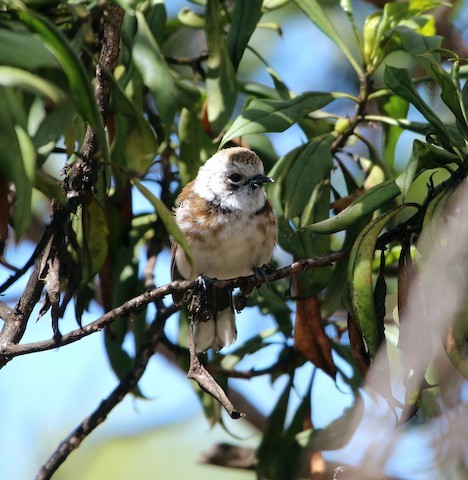
Hawaii Elepaio, C. s. bryani, showing mostly white head and underparts, as is common in this population. (Pu’u La’au, Big Island, Hawaii; September 23, 2013.) © John Drummond
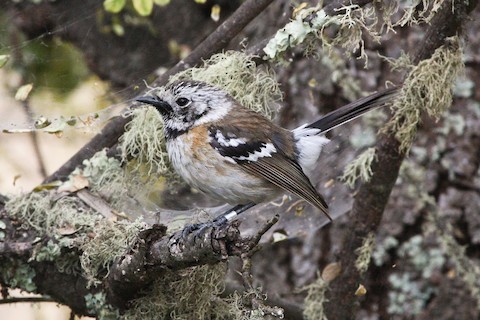
Hawaii Elepaio, C. s. bryani, showing mostly white head and underparts, as is common in this population. (Pu’u La’au, Big Island, Hawaii; June 30, 2008.) © Eric VanderWerf

Hawaii Elepaio, C. s. bryani, with mostly dark plumage typical of other subspecies. (Pu’u La’au, Big Island, Hawaii; June 30, 2008.) © Eric VanderWerf
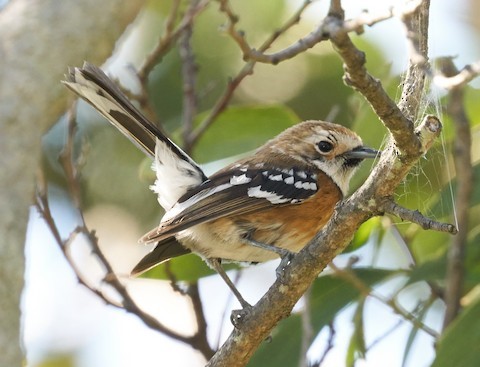
Hawaii Elepaio, showing pale highlights typical of C. s. bryani. (Mauna Loa Road, Hawaii Volcanoes National Park, Big Island, Hawaii; January 16, 2017.) © Brooke Miller
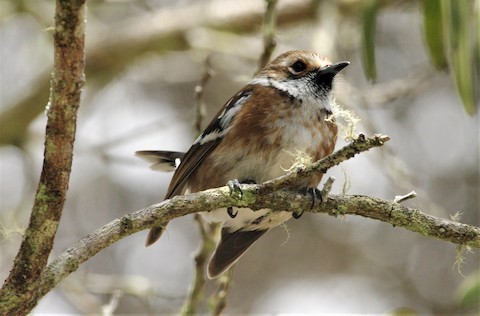
Hawaii Elepaio, with plumage intermediate between bryani and other subspecies. (Pu’u O’o Trail, Kipuka Ainahou, Big Island, Hawaii; March 8, 2011.) © Brenda Wright
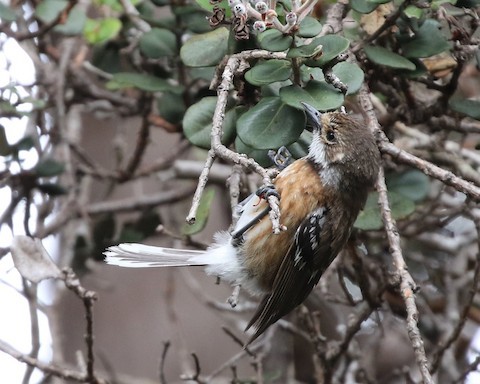
Hawaii Elepaio, with plumage intermediate between bryani and other subspecies. (Pu’u O’o Trail, Kipuka Ainahou, Big Island, Hawaii; September 2, 2019.) © Dean LaTray
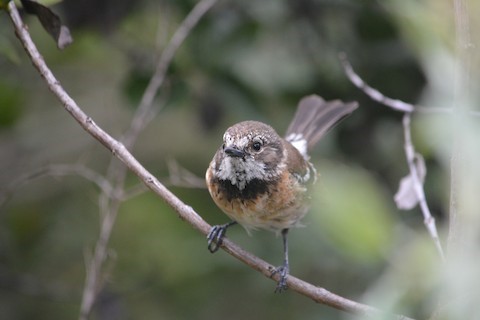
Hawaii Elepaio, C. s. bryani, with plumage intermediate between this and other subspecies. (Pu’u La’au, Big Island, Hawaii; July 9, 2018.) © Alex Wang
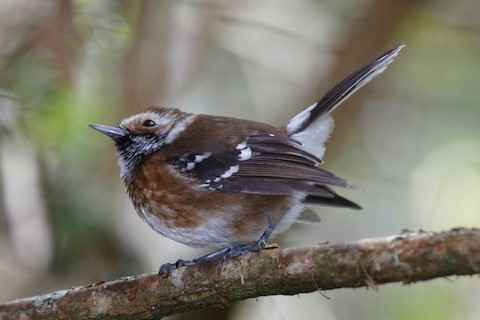
Hawaii Elepaio, with plumage intermediate between bryani and other subspecies. (Pua Akala Tract, Hakalau Forest National Wildlife Refuge, Big Island, Hawaii; October 21, 2017.) © Sharif Uddin
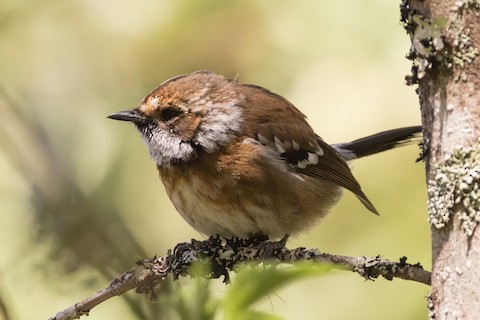
Hawaii Elepaio, with plumage intermediate between bryani and other subspecies. (Pu’u O’o Trail, Kipuka Ainahou, Big Island, Hawaii; March 26, 2017.) © Sharif Uddin
Immature plumage is mostly buffy or pale-brown above and whitish below, but variable. It often shows traces of adult pattern and coloration.
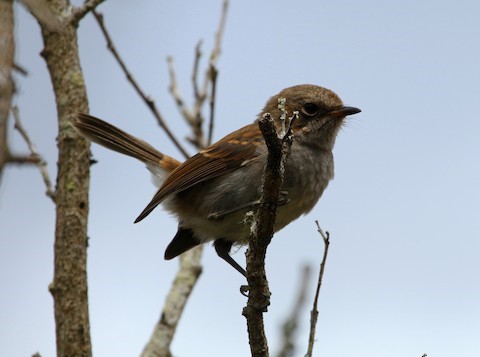
Hawaii Elepaio, immature. (Pu’u O’o Trail, Kipuka Ainahou, Big Island, Hawaii; September 25, 2013.) © John Drummond

Hawaii Elepaio, C. s. bryani, immature. (Pu’u La’au, Big Island, Hawaii; September 12, 2018.) © Bradley Hacker
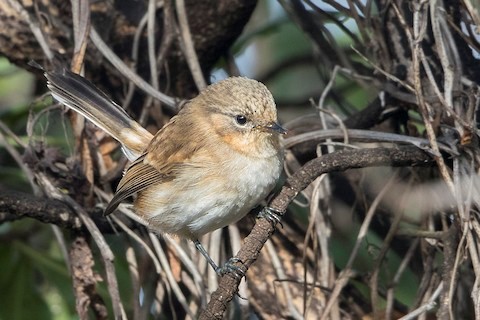
Hawaii Elepaio, C. s. bryani, immature. (Pu’u La’au, Big Island, Hawaii; September 12, 2018.) © Bradley Hacker

Hawaii Elepaio, C. s. bryani, immature. (Pu’u La’au, Big Island, Hawaii; August 27, 2018.) © Bret Mossman

Hawaii Elepaio, immature. (Mauna Loa Trail, Big Island, Hawaii; March 24, 2017.) © Jason Van
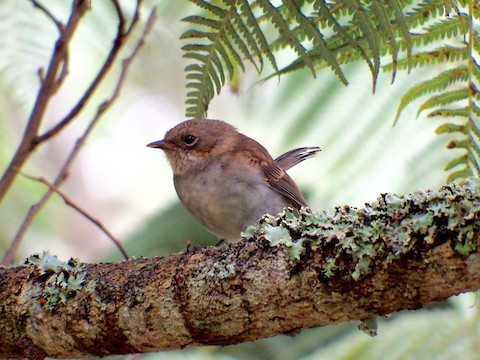
Hawaii Elepaio, immature. (Pu’u O’o Trail, Kipuka Ainahou, Big Island, Hawaii; August 14, 2017.) © Chris Rurik
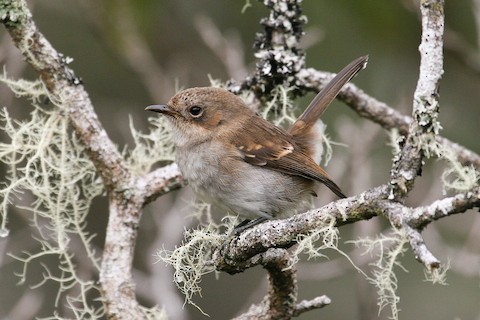
Hawaii Elepaio, immature. (Pu’u O’o Trail, Kipuka Ainahou, Big Island, Hawaii; September 22, 2006.) © Eric VanderWerf
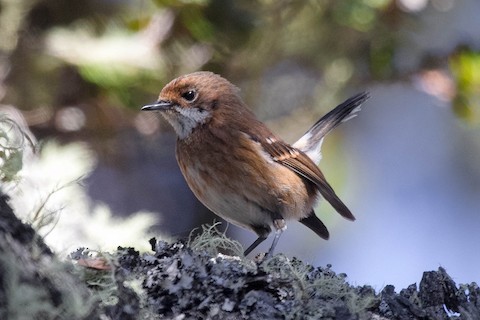
Hawaii Elepaio, female entering adult plumage. (Pua Akala Tract, Hakalau Forest National Wildlife Refuge, Big Island, Hawaii; January 26, 2016.) © Michael Hooper

Hawaii Elepaio, C. s. sandwichensis, immature. (Manuka State Park, Big Island, Hawaii; December 26, 2011.) © Ken Pahlas
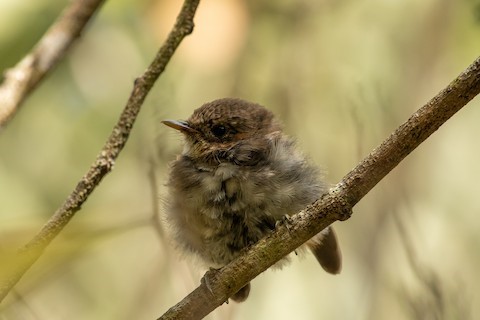
Hawaii Elepaio, fledgling. (Pu’u O’o Trail, Kipuka Ainahou, Big Island, Hawaii; June 11, 2020.) © Alex Wang
Voice. Song is a snappy three-syllable “whirr CHEE-WIT!”: With variations:Calls are nasal, squeaky, sometimes one or two syllables, sometimes more chattery:
Notes
Polytypic species consisting of three recognized subspecies: sandwichensis (western), bryani (north-central), and ridgwayi (eastern).
The status of the subspecies is unsettled. The north-central subspecies, bryani, localized on dry western slopes of Mauna Kea at elevations between 1,900 and 3,000 m, is visually distinctive, and could be regarded as a distinct form, but genetic analyses found no evidence to support dividing C. s. sandwichensis even at the subspecies level (VanderWerf et al. 2010). Typical bryani may be most appropriately regarded as a localized color morph.
IUCN Red List Status: Vulnerable.
References
BirdLife International. 2016. Chasiempis sandwichensis. The IUCN Red List of Threatened Species 2016: e.T22736440A95134209. https://dx.doi.org/10.2305/IUCN.UK.2016-3.RLTS.T22736440A95134209.en. (Accessed July 2, 2020.)
eBird. 2020. eBird: An online database of bird distribution and abundance. Cornell Lab of Ornithology, Ithaca, N.Y. http://www.ebird.org. (Accessed July 2, 2020.)
Moeliker, K., E. de Juana, and J.S. Marks. 2020. Hawaii Elepaio (Chasiempis sandwichensis). In Handbook of the Birds of the World Alive (J. del Hoyo, A. Elliott, J. Sargatal, D.A. Christie, and E. de Juana, eds.). Lynx Edicions, Barcelona. https://www.hbw.com/node/59203. (Accessed May 10, 2020.)
Pratt, H.D., P.L. Bruner, and D.G. Berrett. 1987. A Field Guide to the Birds of Hawaii and the Tropical Pacific. Princeton University Press.
Pratt, H.D. 1993. Enjoying Birds in Hawaii: A Birdfinding Guide to the Fiftieth State (Second Edition). Mutual Publishing, Honolulu, Hawaii.
Pyle, R.L., and P. Pyle. 2017. The Birds of the Hawaiian Islands: Occurrence, History, Distribution, and Status. Version 2 (January 1, 2017). http://hbs.bishopmuseum.org/birds/rlp-monograph/. B.P. Bishop Museum, Honolulu, Hawaii.
VanderWerf, E.A., L.C. Young, N.W. Yeung, and D.B. Carlon. 2010. Stepping stone speciation in Hawaii’s flycatchers: Molecular divergence supports new island endemics within the Elepaio. Conservation Genetics 11:1283-1298.
Xeno-Canto. 2020. Hawaii Elepaio – Chasiempis sandwichensis. https://www.xeno-canto.org/species/Chasiempis-sandwichensis. (Accessed July 2, 2020.)
